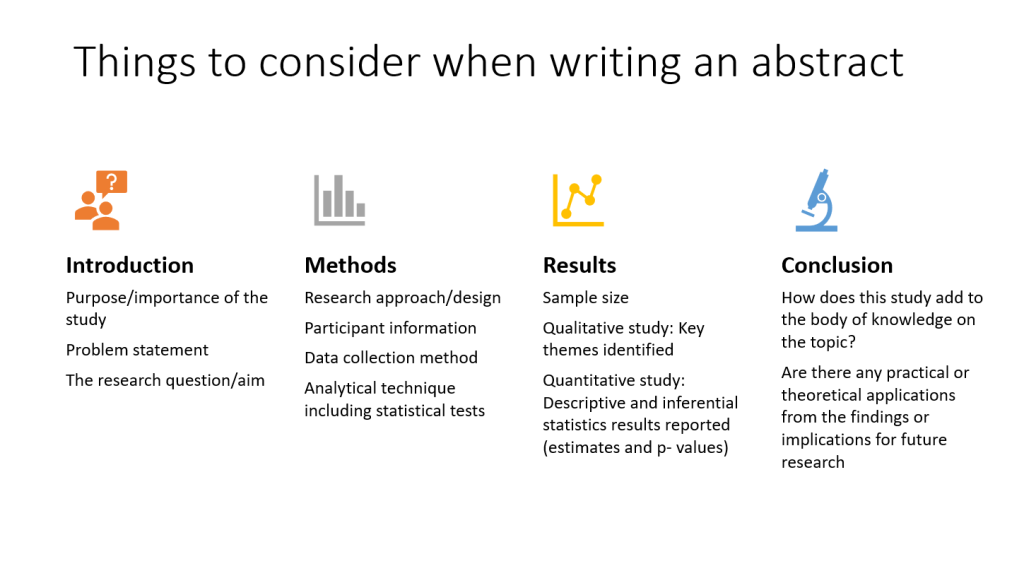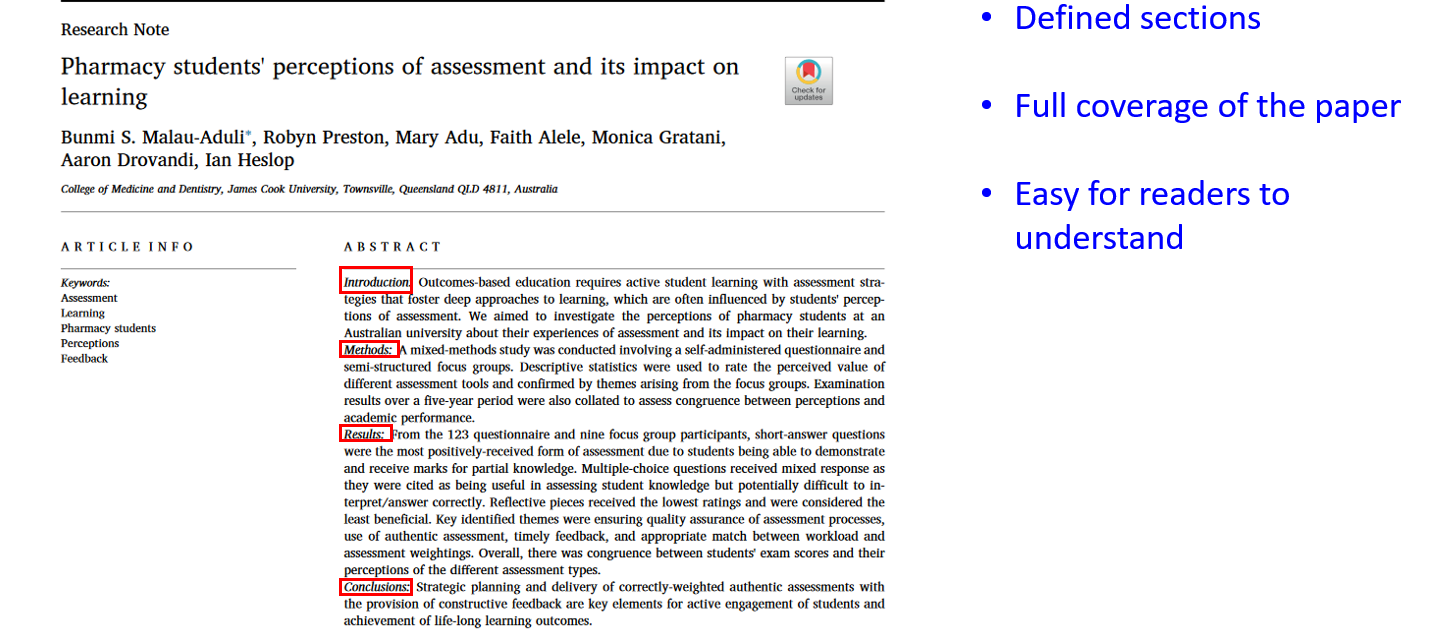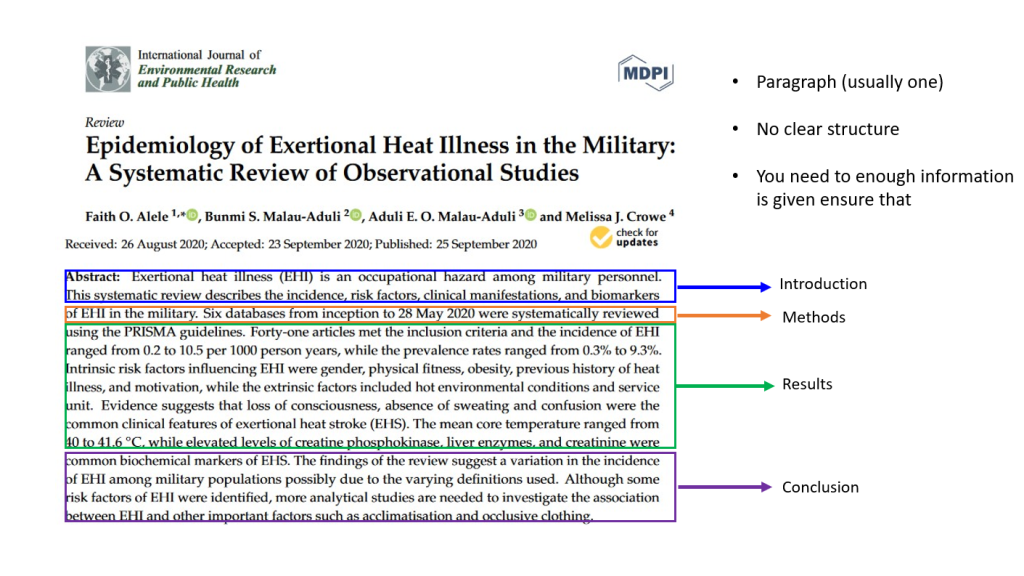7.2 Structure of a Paper
While the format for scientific articles varies by journal type, the general components include an abstract, introduction, methods, results, discussion and references. These components are presented in Table 7.1 and discussed below.
Table 7.1: Components of a research paper
| Sections of paper | Process |
| Abstract | What did the authors do in a nutshell? |
| Introduction | What is the problem? |
| Methods (and materials) | How did the authors solve the problem? |
| Results | What did the authors find out? |
| Discussion | What does it mean? |
| Conclusion | What is the key significance? |
| Acknowledgements (optional) | Who helped the authors out? |
| References | Whose work did the authors refer to? |
| Appendices | Extra information |
Abstract: This is a brief summary of the paper which outlines the aim, methods used, results obtained, and conclusion. It should be concise, highlighting the research’s purpose and major results. The abstract is essential as it gives the reader a quick overview of the paper’s content, provides an opportunity to catch the reader’s attention and assists the reader in deciding whether they want to read the full article in-depth. Figure 7.1 indicates the things to consider when writing an abstract. There are different journal specifications of the abstract format, which could be structured – using sub-headings or unstructured 3 (see Figures 7.2 and 7.3).



Introduction: this is the beginning that establishes the tone for the rest of the paper by providing pertinent background information and stating the issue that needs to be discussed in great detail.4 Consider the introduction as the top of a funnel that starts wide to put the research into a context that someone unfamiliar with the research field might understand.4 In addition, the introduction should provide information about why the study described in the paper has been undertaken.3 Relevant gaps in the literature are identified and clearly stated, and the research questions, objective and hypothesis are stated at the end of the introduction.
Methods: The methods section follows the introduction and it should provide details and a complete description of the following.5 Study design – the study design should be clearly stated
- Study population – A description of the population from which the sample was drawn should be provided. All inclusion and exclusion criteria should also be stated.
- Sampling method – The sampling procedure and sample size should be stated
- Data collection- How data was obtained and the tools used to assess the outcome measures should be provided
- Data analysis: Details of how the data was analysed should be stated. Where quantitative data was collected, the statistical test and the statistical software package used should be stated. In qualitative research, the data analysis approach used should be clearly stated.
- Ethics: Ethical approval statement with the details of the ethics review committee, the date of approval and the approval number should be documented. Please note that some journals may include details about ethics at the end of the article after the reference list).
The methods must be written in enough detail so that another researcher can repeat the study and readers can determine the relevance of the study to their own context/questions. Presentation of the results comes after the methods.
Results: The results section should present the findings of the study in an organised and objective manner laying the groundwork for the Discussion section where those data are interpreted subjectively.4,5 The results section should include the first part, which entails the total number of participants and a description of the basic characteristics of the participants, including age and gender, followed by other sociodemographic characteristics like level of education.4,5 The main results are stated after the description, and this presentation follows the specific research aims at the end of the introduction. It should be indicated in this part where there are missing data points. This section should include tables, figures, graphs and appropriate summaries for these data visualisation tools and referenced in the summaries.4,5 An interpretation of the findings is written in the next section, which is the discussion.
Discussion: The discussion section should interpret the results, relate them to the background and objectives of the study, and draw conclusions.4,5 The opening paragraph summarises the study’s findings and emphasises their novelty and significance. A comparison of these findings to published literature results follows the opening paragraph.4,5 A discussion with a structure that follows the same sequence as the objectives indicated in the introduction and the primary result in the result section makes reading easier. The discussion should also discuss the strengths and limitations of the study and suggest areas for future research and implications for policy and practice.4,5 Following the discussion is the conclusion.
Conclusion: The conclusion is usually found as a separate section after the discussion. It is the final section of the research paper where the main findings are summarized, and the implications for future research are discussed. Some journal styles may require the conclusion as the last paragraph of the discussion. The conclusions should convey the findings’ relevance.3,4 The conclusion should summarise the results of the study in a way that includes fresh insights or poses fascinating issues that developed as a consequence of the research rather than just restating the key findings.3,4
References: The list of references is placed after the conclusion, and this section lists all sources of information cited in the paper. It usually follows a specific citation style (such as APA, MLA, AMA, Vancouver, Havard, or Chicago).5 The references should be organised according to the referencing style format prescribed by the journal and should be up to date. The use of appropriate references adds credibility to the study and strengthens the arguments made in the discussion.5
Activity 7.1: In this section, we would want you to engage with the interactive book, in which we have analysed the different components (parts) of a paper.

